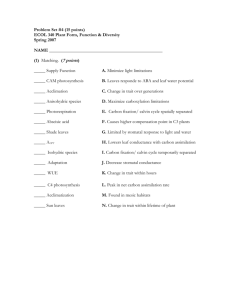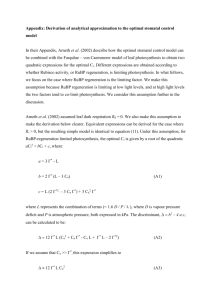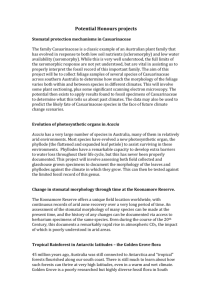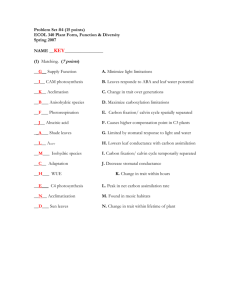Supplementary Data Central functions of bicarbonate in S
advertisement
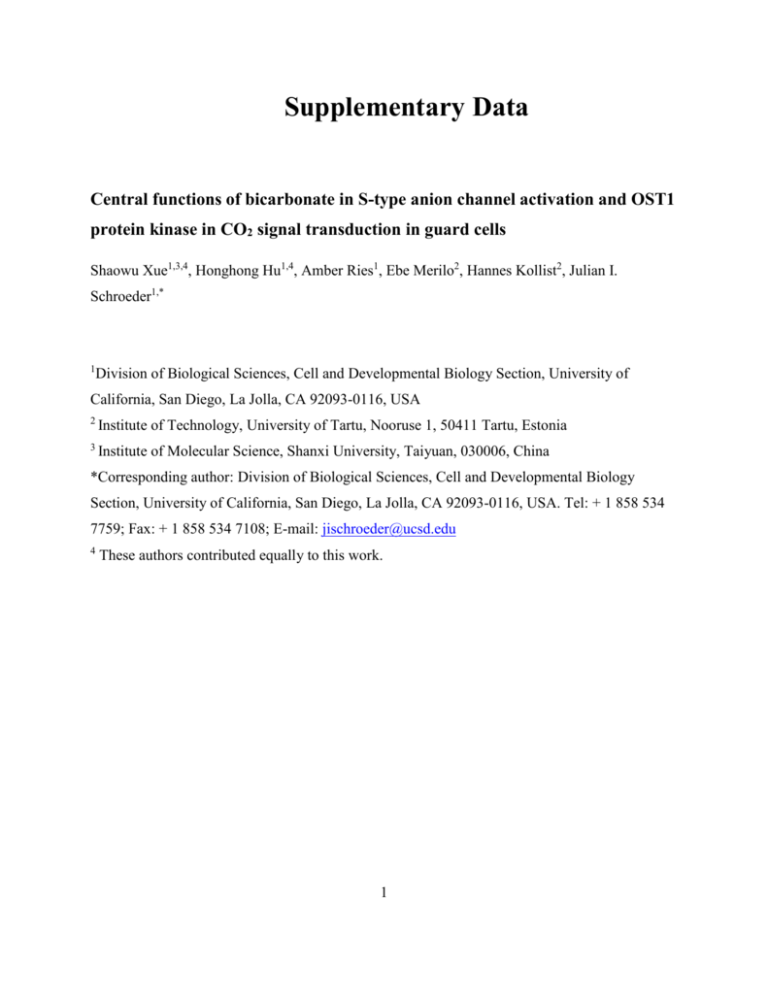
Supplementary Data Central functions of bicarbonate in S-type anion channel activation and OST1 protein kinase in CO2 signal transduction in guard cells Shaowu Xue1,3,4, Honghong Hu1,4, Amber Ries1, Ebe Merilo2, Hannes Kollist2, Julian I. Schroeder1,* 1 Division of Biological Sciences, Cell and Developmental Biology Section, University of California, San Diego, La Jolla, CA 92093-0116, USA 2 Institute of Technology, University of Tartu, Nooruse 1, 50411 Tartu, Estonia 3 Institute of Molecular Science, Shanxi University, Taiyuan, 030006, China *Corresponding author: Division of Biological Sciences, Cell and Developmental Biology Section, University of California, San Diego, La Jolla, CA 92093-0116, USA. Tel: + 1 858 534 7759; Fax: + 1 858 534 7108; E-mail: jischroeder@ucsd.edu 4 These authors contributed equally to this work. 1 Supplementary Table Ι. Cytosolic free [Ca2+]i and free [HCO3-]i activation of anion currents at a voltage of -146 mV. [Ca2+]i (µM) [HCO3]i (mM) I (pA) at -146 mV 0.15 0 -16.4 ± 2.0a 2 0 -15.6 ± 4.0b 0.76 (b vs. a) 6 0.15 11.5 -22.3 ± 2.3c 0.071 (c vs. a) 7 2 5.75 -21.8 ± 3.2d 0.054 (d vs. b) 7 2 11.5 -58.7 ± 5.9e < 0.001* (e vs. b) 10 P value Cell number 5 0.056 (f vs. a) 7 0.35 (f vs. c) a-f Current values from Figure 4G for comparison. Data are mean ± s.e. *Stands for significant difference using Student’s t-test. 0.6 11.5 -27.3 ± 4.5f 2 Supplementary Figures Figure S1. No large S-type anion currents were activated by extracellular application of with bicarbonate. (A) Whole-cell currents recording in Col-0 wild type guard cells (n = 6). The bath solution contained 30 mM CsCl, 2 mM MgCl2, 1 mM CaCl2 and 10 mM Mes/Tris, pH 5.6. The pipette solution contained 150 mM CsCl, 2 mM MgCl2, 6.7 mM EGTA, 6.03 mM CaCl2 (2 µM [Ca2+]i), 5 mM Mg-ATP, 5 mM Tris-GTP, 1 mM HEPES/Tris, pH 7.1. Liquid junction potential was -1 mV. (B) Whole-cell recording of guard cells perfused with total 13.5 mM bicarbonate-containing solution (11.5 mM free HCO3- and 2 mM CO2) at pH 7.1. The other components of the bath were 30 mM CsCl, 2 mM MgCl2, 1 mM CaCl2 and 10 mM HEPES/Tris, pH 7.1. Bath volume was 200 µl and perfused for 2 min at 1 ml/min. n = 6. Liquid junction potential was -2 mV. (C) Steady-state current-voltage relationships of whole-cell currents as shown in (A) and (B). At a voltage of -144 mV, the control (background) current was -13 ± 5 pA (n = 6), and the current was -17 ± 5 pA in a bicarbonate-containing solution (n = 6), P > 0.05. 3 Figure S2. Reversal potential of S-type anion currents activated by 50 mM total bicarbonate added to the pipette solution. (A) Typical recording of S-type anion currents activated by intracellular 50 mM total bicarbonate. 50 mM total bicarbonate at pH 7.1 equivalent to 43.4 mM free [HCO3-]i and 6.6 mM [CO2] was calculated using the Henderson-Hasselbalch equation as described in the Methods. (B) Steady-state current-voltage relationship showed reversal potential of S-type anion currents at + 26.0 ± 0.9 mV (n = 4). Data are mean ± s.e. Liquid junction potential was + 3 mV. 4 Figure S3. Extracellular pH shifts cause measurable intracellular pH changes in guard cells. Fluorescence ratio time series of guard cells from another transformed line expressing pH sensitive reporter Pt-GFP during extracellular perfusion with buffers of different pH as indicated by the top bar (See also Figure 2D). GC denotes ratiometric fluorescence in guard cells and the ratio of non-guard cell background fluorescence (bg) is shown for the same experiments. 5 Figure S4. CO2-induced stomatal closure in ost1 and pyr1;pyl1;pyl2;pyl4 quadruple mutant mutants. (A) Stomatal conductance responses to [CO2] in ost1-3 mutant and Col-0 wild type intact leaves (n = 4 for each genotype). (B) Stomatal conductance in responses to [CO2] changes in intact ost1-3 and Col-0 wild type plants (n = 8 for ost1-3, n = 6 for WT). (C) Stomatal conductance in responses to [CO2] changes in intact ost1-1, ost1-2 and Ler wild type plants (n = 4 for each genotype). Data shown in Figure 7B, C and D were normalized in (A), (B) and (C), respectively. (D) Stomatal conductance in responses to [CO2] changes in pyr1;pyl1;pyl2;pyl4 mutant and Col-0 wild type intact leaves (n = 4 for each genotype). Data shown in Figure 8A were normalized in (D). Imposed CO2 concentrations are shown at the bottom. Data are mean ± s.e. 6 Supplementary Methods Solutions for patch clamp experiments For analyses of S-type anion currents, the pipette solution contained 150 mM CsCl, 2 mM MgCl2, 6.7 mM EGTA, 2.61 mM CaCl2 (150 nM [Ca2+]i), 4.84 mM CaCl2 (0.6 µM [Ca2+]i), or 6.03 mM CaCl2 (2 µM [Ca2+]i), 5 mM Mg-ATP, 5 mM Tris-GTP, 1 mM HEPES/Tris, pH 7.1. For experiments analyzing effects of protons on S-type anion currents, the pipette solution contained 150 mM CsCl, 2 mM MgCl2, 6.7 mM EGTA, 0.6 mM CaCl2 (2 µM [Ca2+]i), 5 mM Mg-ATP, 5 mM Tris-GTP, 1 mM MES/Tris, pH 6.1. For experiments with pipette solution at pH 7.8, the pipette medium contained 150 mM CsCl, 2 mM MgCl2, 2 µM free [Ca2+]i, 5 mM Mg-ATP, 5 mM Tris-GTP, 1 mM HEPES/Tris. Calcium affinities of EGTA and free Ca2+ concentrations were calculated using the WEBMAXC tool (http://www.stanford.edu/~cpatton/webmaxc/webmaxcE.htm), which considers pH, [ATP] and ionic conditions. The bath solution contained 30 mM CsCl, 2 mM MgCl2, 5 mM CaCl2 and 10 mM Mes/Tris, pH 5.6. Osmolalities of all solutions were adjusted to 485 mmol·kg-1 for bath solutions and 500 mmol·kg-1 for pipette solutions by addition of D-sorbitol. Stomatal conductance measurements Stomatal conductance measurements of 5-week-old plants in response to the imposed [CO2] at a light (PAR) fluence rate of 150 µmol m-2 s-1 were conducted with a Li-6400 gas exchange analyzer with a fluorometer chamber (Li-Cor Inc.) as described previously (Hu et al, 2010). Relative stomatal conductance values of intact leaves were calculated by normalization relative to 365 or 400 ppm just before transition to 800 ppm [CO2]. Data shown are mean s.e. of at least 3 leaves per genotype in the same experimental set. For whole-plant gas-exchange experiments, 24 to 26-day-old plants were used. Plants were grown in pots as described previously (Kollist et al, 2007). For monitoring CO2-induced changes in whole-plant stomatal conductance, a custom made device for Arabidopsis wholeplant gas-exchange measurements was used (Kollist et al, 2007). Before application of different CO2 treatments, plants were acclimated in the measuring cuvettes for at least 1 h (Vahisalu et al, 2008). Experiments were performed at photosynthetic photon flux density of 150 ± 3 µmol m -2 s1 , relative humidity of 60-70% (vapour pressure deficit = 0.9-1.2 kPa) and air temperature of 247 25 ºC. Photographs of plants were taken before the experiment and rosette leaf area was calculated using ImageJ 1.37v (National Institutes of Health, USA). Stomatal conductance for water vapour was calculated as described previously (Kollist et al, 2007; Vahisalu et al, 2008). Data were normalized relative to the stomatal conductance at 400 ppm [CO2] just before the transition to 100 ppm [CO2]. Stomatal aperture measurements Three to 4-week-old plants grown in a plant growth chamber were used for analyses of stomatal movements in response to ambient and elevated [CO2]. Intact leaf epidermal layers with no mesophyll cells in the vicinity and ambient or high [CO2] (800 ppm) incubation buffers were prepared as described (Hu et al., 2010; Young et al., 2006). Leaf epidermal layers were preincubated for 1.5 h in a buffer containing 10 mM MES, 10 mM KCl, 50 µM CaCl2 at pH 6.15 and then perfused with incubation buffers continually bubbled with ambient air or 800 ppm CO2 for 30 min. For stomatal movement analyses in pyr1;pyl1;pyl2;pyl4 quadruple mutant plants, individual stomata were imaged and individually tracked as previously reported (Siegel et al, 2009). Stomatal apertures were measured using ImageJ software and analyzed. Data shown are from genotype blind analyses (n = 3 experiments, 40 stomata per experiment and condition). Supplementary Reference Hu H, Boisson-Dernier A, Israelsson-Nordstrom M, Bohmer M, Xue S, Ries A, Godoski J, Kuhn JM, Schroeder JI (2010) Carbonic anhydrases are upstream regulators of CO 2-controlled stomatal movements in guard cells. Nat Cell Biol 12: 87-93 Kollist T, Moldau H, Rasulov B, Oja V, Ramma H, Huve K, Jaspers P, Kangasjarvi J, Kollist H (2007) A novel device detects a rapid ozone-induced transient stomatal closure in intact Arabidopsis and its absence in abi2 mutant. Physiol Plantarum 129: 796-803 Siegel RS, Xue S, Murata Y, Yang Y, Nishimura N, Wang A, Schroeder JI (2009) Calcium elevation-dependent and attenuated resting calcium-dependent abscisic acid induction of stomatal closure and abscisic acid-induced enhancement of calcium sensitivities of S-type anion and inward-rectifying K+ channels in Arabidopsis guard cells. Plant J 59: 207-220 Vahisalu T, Kollist H, Wang YF, Nishimura N, Chan WY, Valerio G, Lamminmaki A, Brosche M, Moldau H, Desikan R, Schroeder JI, Kangasjarvi J (2008) SLAC1 is required for plant guard cell S-type anion channel function in stomatal signalling. Nature 452: 487-491 8 Young JJ, Mehta S, Israelsson M, Godoski J, Grill E, Schroeder JI (2006) CO2 signaling in guard cells: calcium sensitivity response modulation, a Ca2+-independent phase, and CO2 insensitivity of the gca2 mutant. Proc Natl Acad Sci USA 103: 7506-7511 9
